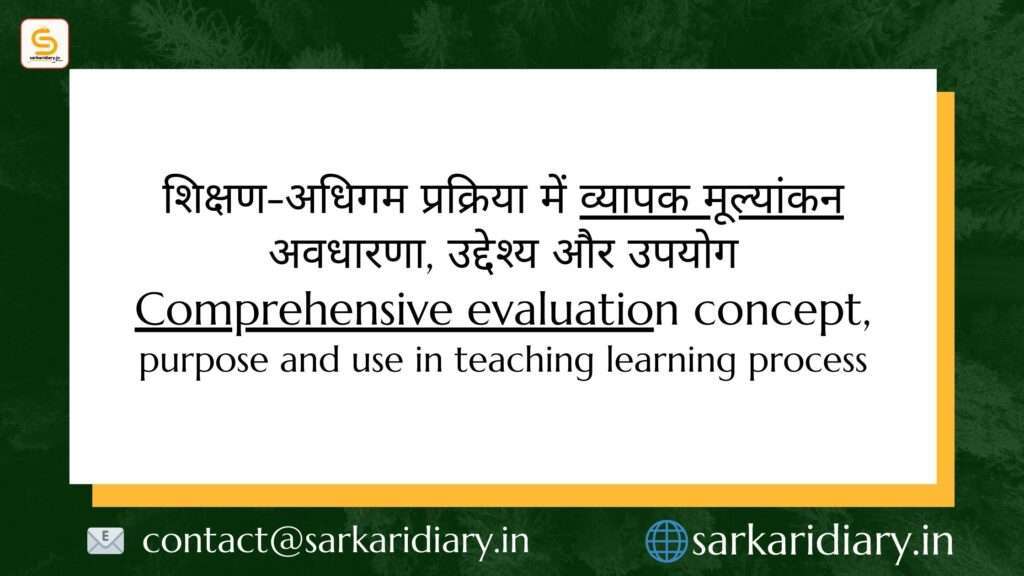Concept of Comprehensive Evaluation:
Concept of Comprehensive Evaluation: Comprehensive evaluation is a holistic approach to assessment that aims to evaluate all aspects of a student’s learning and development. It goes beyond traditional methods of assessment, which often focus on end-of-term exams or standardized tests, and instead incorporates a variety of assessment tools and techniques to gather a more comprehensive picture of a student’s progress.

What is Comprehensive Evaluation?
Comprehensive evaluation is an assessment approach that takes into account various aspects of a student’s learning, including their knowledge, skills, attitudes, and values. It goes beyond traditional methods of evaluation, such as exams and tests, and focuses on a more comprehensive understanding of a student’s overall development.
Unlike conventional evaluation methods that only measure a student’s academic performance, comprehensive evaluation considers other essential aspects, such as their social skills, creativity, problem-solving abilities, and emotional intelligence. It provides a more holistic and well-rounded assessment of a student’s capabilities, enabling educators to gain a deeper insight into their strengths and areas for improvement.
Purpose of Comprehensive Evaluation
The primary purpose of comprehensive evaluation is to promote a student-centered approach to education. It aims to assess the overall development of students and provide them with feedback that helps them grow academically, socially, and emotionally. By focusing on a broader range of skills and competencies, comprehensive evaluation encourages a more comprehensive understanding of a student’s abilities.
Comprehensive evaluation also aims to identify and address the individual needs and learning styles of students. It helps educators tailor their teaching methods and strategies to cater to the diverse needs of their students, ensuring that each student receives the necessary support and guidance to reach their full potential.
Furthermore, comprehensive evaluation promotes self-reflection and self-assessment among students. By actively involving students in the evaluation process, it encourages them to take ownership of their learning and become more self-directed learners.
or
The primary purpose of comprehensive evaluation is to improve student learning. By providing teachers with a more detailed understanding of each student’s strengths and weaknesses, comprehensive evaluation can help inform instructional decisions and provide students with the targeted support they need to succeed.
Use of Comprehensive Evaluation in the Teaching-Learning Process
Comprehensive evaluation can be used throughout the teaching-learning process to inform and improve instruction. Here are some specific examples of how comprehensive evaluation can be used:
Formative assessment: Comprehensive evaluation can be used formatively, or to provide feedback to students and teachers during the learning process. This feedback can help students identify areas where they need to improve and teachers adjust their instruction accordingly.
Summative assessment: Comprehensive evaluation can also be used summatively, or to assess student learning at the end of a unit or course. This type of assessment can be used to measure student progress and identify areas where students may need additional support.
Identifying individual needs: Comprehensive evaluation can be used to identify the individual needs of students. This information can be used to provide students with differentiated instruction and support.
Tracking progress over time: Comprehensive evaluation can be used to track student progress over time. This information can be used to identify trends in student learning and make adjustments to instruction accordingly.
Benefits of Comprehensive Evaluation
There are many benefits to using comprehensive evaluation in the teaching-learning process. Some of the key benefits include:
Improved student learning: Comprehensive evaluation can help to improve student learning by providing teachers with a more detailed understanding of each student’s strengths and weaknesses.
Reduced stress and anxiety: Comprehensive evaluation can help to reduce stress and anxiety in students by shifting the focus from high-stakes exams to a more holistic approach to assessment.
Increased engagement: Comprehensive evaluation can help to increase student engagement by making learning more meaningful and relevant.
Improved communication: Comprehensive evaluation can help to improve communication between teachers, students, and parents by providing a common language for discussing student progress.
Overall, comprehensive evaluation is a valuable tool that can be used to improve the teaching-learning process and promote student success.